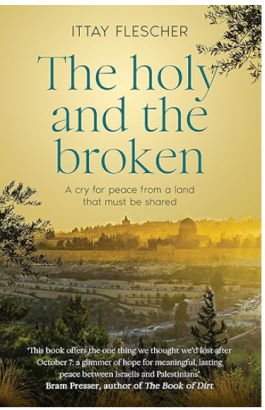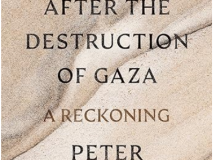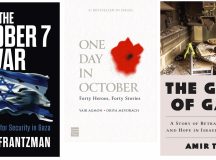One of the most moving moments in Ittay Flescher’s new memoir, The Holy and the Broken, takes place moments after the beginning of the horrendous attack by Hamas on 7 October 2023.
Cowering in a South Jerusalem bomb shelter with his religious and secular neighbours, Flescher is forced to answer his 11-year-old son’s innocent questions about what was transpiring. ‘How is Gaza different than Jerusalem?’ His son asks. ‘How many people live there? What is a siege?’ The seasoned journalist was at a loss for words.
For those of us, like me, whose first political memory in Jerusalem was Saddam Hussein’s scud missile attack during the 1991 Gulf war, Flescher’s sentiments may at times seem sentimental or over the top. We Israelis are jaded. But he has a knack for describing raw pain with innocent brush strokes.
Based on his experience as an informal educator in Melbourne and Jerusalem, Flescher’s overarching theory is that personal acquaintance between Jews and Arabs can go a long way to bring peace closer. As both a teacher and a journalist, Flescher is also keenly aware of the ability of words to change hearts and minds.
The book oscillates between descriptions of the present moment and historic highlights of the Arab-Israeli conflict going back to the late 19th century. Though much of this material has been covered by earlier books, some interesting passages shed light on our current predicament.
One such chapter is dedicated to the correspondence between Jerusalem’s Palestinian mayor Yusuf al-Khalidi and Theodor Herzl in 1899. In his letter to Herzl, Khalidi expresses deep appreciation for the Zionist visionary, but also scepticism about his ability to realise his national dream given the geopolitical circumstances of the time. ‘Even the nations best disposed towards the Jews, like the English and the Americans, I do not believe that they will ever agree to go to war against other nations to help the Jews settle in Palestine,’ Khalidi wrote to Herzl. Boy, was he wrong. Britain and the US may not have gone to war against other nations for the sake of Jewish settlement, but they did risk their relations with Arab countries over the years for the sake of Israel.
But Herzl was no less naive. He tried to convince the Jerusalem mayor that both Palestinians and the Ottoman Sultan would be amenable to Jewish migration to the land solely for their economic benefit. ‘I have submitted to his majesty the sultan some general propositions, and I am pleased to believe that the extreme clearness of his mind will make him accept in principle. The idea of which one can afterwards discuss the details of execution. If he will not accept it, we will search and, believe me, we will find elsewhere what we need.’ The hope that the Sultan would accept the Jewish plea for sovereignty in the Middle East, we can now conclude, has not aged well.
As Flescher points out, the cordial discourse between Khalidi and Herzl is hard to imagine between Jewish and Palestinian leaders today. But what may still be true is the fact that both sides still do not fathom the deep-seated connection of the other to the land, nor their determination to safeguard their national interests at all costs.
It is quite audacious to write a book focused on the Gaza-Israel war while it is still raging. But what makes The Holy and the Broken stand out from the plethora of writing on the devastating violence plaguing our land, is his unique perspective as an Australian immigrant to Israel. One of the most interesting chapters of the book is chapter 5, entitled ‘Indigenous Australians, Jews, and Palestinians.’
Flescher admits he only educated himself on the Aboriginal history of his native Australia after graduating from high school. As a former informal educator at Mount Scopus Memorial College, a Jewish School in Melbourne, he prides himself in founding a programme called ‘Yorta Yorta Beyachad’, an attempt to teach Australian history through Aboriginal eyes. Flescher says the programme was life-changing for his Jewish students. It clearly informed his understanding of indigeneity, history, and narrative in the Israeli Palestinian context as well.
The chapter ends with Flescher describing how he casted his vote in the 2023 Australian referendum entitled ‘The Voice’ – a bid to grant greater representation to indigenous Australians – at the Australian embassy in Tel Aviv. ‘While I voted YES, I couldn’t help but feel that it was deeply unfair that whether or not Aboriginal and Torres Strait Islanders would have a voice in Parliament on laws that affect them was up to me and the other 97% of Australians who had no history in the country prior to 1788,’ Flescher remarks.
‘Putting that slip of paper in the ballot box, I also said a little prayer for the future, hoping that at the end of a meaningful truth and reconciliation process, a government may one day exist on the shores of the Mediterranean that hears and represents the voices of every person under its jurisdiction so that the law is no longer favour one specific group at the expense of another, but rather are made for the common good,’ he concludes.
But the comparison of the Israeli and Australian contexts is somewhat unfair to the Israelis, currently in the throes of war. Flescher refers to (mostly symbolic) gestures such as public apologies by former prime ministers Paul Keating and Kevin Rudd, and the ‘Acknowledgement of Country’ made in most public events, acknowledging the aboriginal custodians of the territory. But such gestures by national leaders are the generosity of winners. European colonialism has succeeded in dispossessing and all but erasing the native culture.
Flescher quotes an interviewee in the controversial Israeli documentary Tantura, who remarks that unlike the Australian recognition of past injustices, Israeli acknowledgement of the Nakba ‘doesn’t even glitter on the horizon of public life in Israel.’ But given the failure of the recent ‘The Voice’ referendum, which was also largely symbolic, do Australians really have so much to pat themselves on the back over? The comparison of Israel and Australia also masks the significant political and historical differences between white settler colonialism in ‘the new world’ and the Zionist project, which led to a struggle between two national independence movements. It may also have been worth noting that while, remarkably, Palestinian citizens of Israel received the right to vote in the first national elections in January 1949 – still in the midst of the War of Independence – it wasn’t until the federal elections of 1963 that all Aboriginal and Torres Strait Islander adults got the right to vote.
As he notes a number of times throughout the book, Flescher, the education director at kids4Peace Jerusalem, is often challenged for being hopelessly naive in his aspiration to fix the Palestinian-Israeli conflict. The most recent example of such a confrontation took place when Flescher walked out of a podcast recording with Israel advocate Eylon Levy. He later described his willingness to engage with Levy as a mistake.
In the book’s final chapter, Flescher vulnerably exposes his dream of an idyllic peace, sometime in the future. An Israeli leader would acknowledge the pain and displacement of Palestinians in the 1948 war. A Palestinian leader would acknowledge and pay tribute to the victims of the Nova music festival massacre.
But Flescher is much more realistic when he examines Israel’s failure on the media front. In chapter 10 of his book, he correctly points to the fact that most young Australians derive their information on the conflict not from mainstream media, but rather from social media, an arena where Palestinians have clearly trounced Israel. Reporting on Israel for the Australian online publication The Jewish Independent, Flescher advocates a form of journalism he dubs ‘peace journalism,’ which will highlight positive rather than negative stories about Israeli-Palestinian relations.
Jerusalem, in Flescher’s eyes, is a microcosm of the confederation model he favours as the solution to the conflict. He rejects the two-state model, seeing it as likely to maintain the state of animosity between Jews and Arabs. I share his optimism about the ability of warring sides to achieve peace, even when that goal seems impossible. The peace treaty with Egypt, though far from perfect, is a good example of that. It is when Flescher speaks of his dream for ‘full equality in social, economic and political rights’ in one land, that he loses me and many other Israelis on the moderate left, who still view political separation into two nation states as a better guarantee for Israel’s safety and Jewish character in the long run.
At a time when Israelis, and indeed Jews worldwide, have never been more cynical and pessimistic about the future, The Holy and the Broken offers readers a glimmer of hope. For those seeking both an insightful look back to the past and a hopeful look to the future, Flescher’s book is a worthwhile read.



































